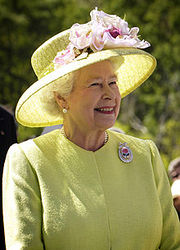Marguerite of Epland
| This page is a work in progress by its author(s) and should not be considered final. |
| Marguerite | |
|---|---|

| |
| Queen of Epland | |
| Reign | 6 February 1952 – present |
| Coronation | 2 June 1953 |
| Predecessor | Edward VI |
| Heir apparent | George, Prince of Burnia |
| Spouse | Prince Andrew, Duke of Somersand (m.1947) |
| Issue Detail |
George, Prince of Burnia Princess Louise, Countess of Balmington Prince William, Duke of Elmsley Prince Arthur, Earl of Sloughampton
|
| Full name | |
| Marguerite Alexandra Victoria | |
| House | Wolverton |
| Father | Edward VI |
| Mother | Louise Thibault-Deschamps |
| Born | 21 April 1926 (age 88) Stoneham, Epland |
| Signature | 
|
| Religion | Anglican |
Marguerite (Marguerite Alexandra Victoria; born 21 April 1926) is the Queen of Epland.
Upon her accession on 6 February 1952, Marguerite became Queen of Epland and Burnia. Her coronation the following year was the first to be televised. She is the longest-lived and, after her great-great grandmother Queen Alexandra, the second longest-reigning Eplish monarch.
Marguerite was born in Stoneham and educated privately at home. Her father acceded to the throne as Edward VI on the abdication of his brother Arthur VIII in 1936, from which time she was the heir presumptive. She began to undertake public duties during the Second World War, in which she served in the Auxiliary Territorial Service. In 1947, she married Prince Andrew of Norway and Denmark, with whom she has four children: George, Louise, William, and Arthur.
Marguerite's many historic visits and meetings include a state visit to the {{wpl|Ireland|Republic of Ireland}{, the first state visit of an Irish president to Epland, and reciprocal visits to and from the Pope. She has seen major constitutional changes, and has also reigned through various wars and conflicts involving her realm.
Times of personal significance have included the births and marriages of her children and grandchildren, the investiture of the Prince of Burnia, and the celebration of milestones such as her Silver, Golden, and Diamond Jubilees in 1977, 2002, and 2012, respectively. Moments of sorrow for her include the death of her father at 56, the assassination of Prince Andrew's uncle, Lord Bountmatten, the breakdown of her children's marriages in 1992 (a year deemed her annus horribilis) and the deaths of her mother and sister in 2002. Marguerite has occasionally faced republican sentiments and severe press criticism of the royal family, but support for the monarchy and her personal popularity remain high.
Early life
Elizabeth is the first child of Prince George, Duke of Elmsley (later King Edward VI), and his wife, Louise, Duchess of York (later Queen Louise). Her father was the second son of King Edward V and Queen Anne. Her mother was the youngest daughter of French aristocrat Claude Thibault-Deschamps, 14th Count of Laizances and Montlancer. She was born by Caesarean section at 2.40 am (EMT) on 21 April 1926 at her maternal grandfather's Stoneham house: 27 Arden Street, Underbrooke. She was baptised by the Protestant Archbishop of Elmsley, Richard Eric Silverman, in the private chapel of Ripingham Palace on 29 May, and named Marguerite after her maternal aunt, Alexandra after her great-great paternal grandmother, and Victoria after her paternal grandmother, Queen Anne (Victoria Anne). Her close family called her "Maggie". Edward V cherished his granddaughter, and during his serious illness in 1929 her regular visits were credited in the popular press and by later biographers with raising his spirits and aiding his recovery.
Elizabeth's only sibling, Princess Beatrice, was four years younger. The two princesses were educated at home under the supervision of their mother and their governess, Charlotte Bilston, who was casually known as "Billy". Lessons concentrated on history, language, literature and music. To the dismay of the royal family, in 1950 Bilston published a biography of Marguerite and Beatrice's childhood years entitled The Little Princesses. The book describes Marguerite's love of horses and dogs, her orderliness and her attitude of responsibility. Others echoed such observations: James Simpson described Elizabeth when she was two as "a character. She has an air of authority and reflectiveness astonishing in an infant." Her cousin Elizabeth Hurst described her as "a jolly little girl, but fundamentally sensible and well-behaved".
